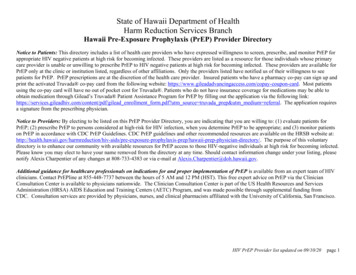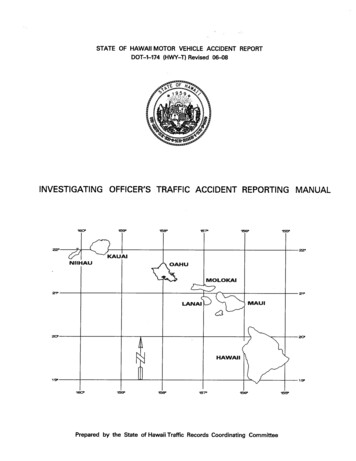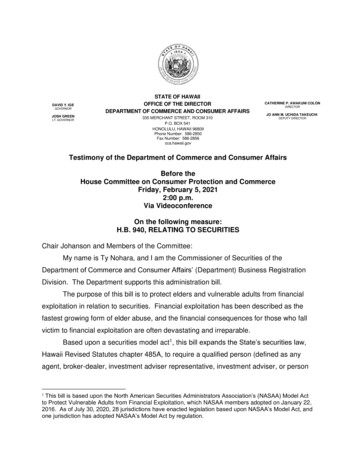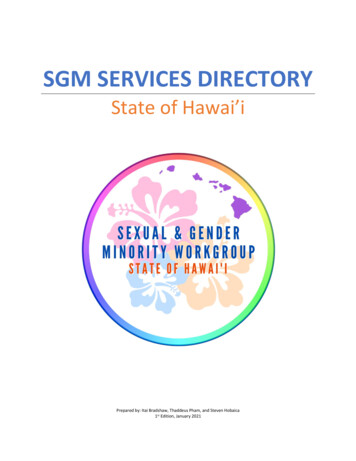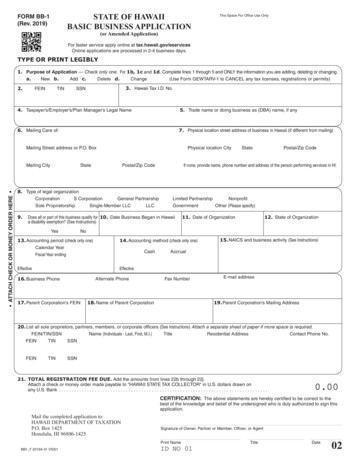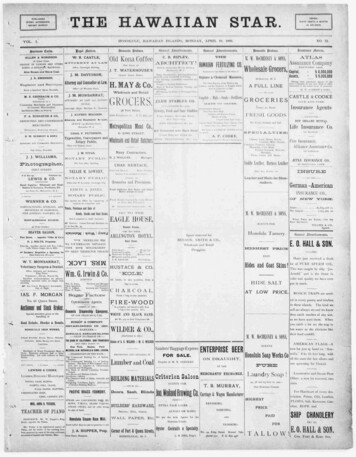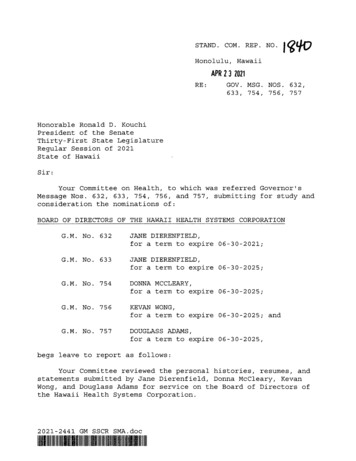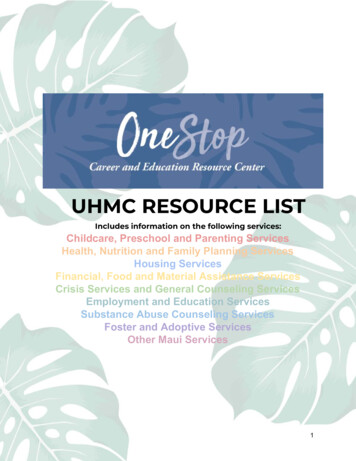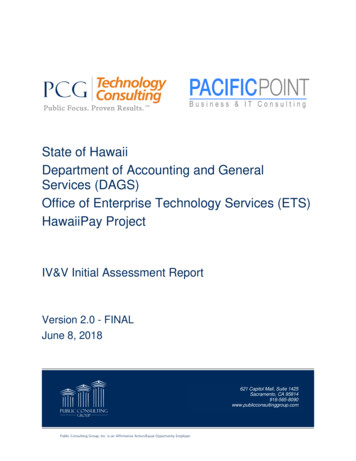
Transcription
State of HawaiiDepartment of Accounting and GeneralServices (DAGS)Office of Enterprise Technology Services (ETS)HawaiiPay ProjectIV&V Initial Assessment ReportVersion 2.0 - FINALJune 8, 2018621 Capitol Mall, Suite 1425Sacramento, CA 95814916-565-8090www.publicconsultinggroup.com
HawaiiPay ProjectIV&V Initial Assessment Report - FinalJune 8, 20181. Document HistoryVersionDateBrief Description of Modifications0.1April 20, 2018Draft assessment template submitted for state review1.0May 18, 2018Draft IV&V Initial Assessment Report submitted for state review1.1May 29, 2018Revised draft submitted for state review2.0June 8, 2018Final IV&V Initial Assessment Report submitted to state2. Document Author & Contact InformationNameTitleContact InformationMichael ForsPCG Project Managermfors@pcgus.comKen WilmothPCG HCM / ERP SMEkwilmoth@pcgus.comTraci VetetoPCG PM SMEtveteto@pcgus.comDocument HistoryPage i
HawaiiPay ProjectIV&V Initial Assessment Report - FinalJune 8, 2018TABLE OF CONTENTS1.2.3.EXECUTIVE SUMMARY . 41.1.Background . 41.2.Key Initial Findings . 51.3.Initial IV&V Dashboard . 6OVERVIEW . 82.1.Purpose . 82.2.Scope . 82.3.Approach . 82.4.Industry Standards and Best Practices . 102.5.Reference Documents . 102.6.Terms and Definitions . 11ANALYSIS AND FINDINGS .133.1.Communications Management . 133.2.Contract Management . 143.3.Cost and Schedule Management . 163.4.Human Resources Management. 183.5.Knowledge Transfer . 213.6.Operational Preparedness . 213.7.Organizational Change Management . 233.8.Project Organization and Management . 273.9.Quality Management . 303.10.Requirements Management . 333.11.Risk Management . 343.12.Systems Architecture and Design . 35APPENDIX A: IV&V FINDINGS AND RATINGS DEFINED .37APPENDIX B: ASSESSMENT CATEGORY DEFINITIONS AND RATINGS .40APPENDIX C: INTERVIEWS CONDUCTED .44Table of ContentsPage ii
HawaiiPay ProjectIV&V Initial Assessment Report - FinalJune 8, 2018Table of TablesTable 1: HawaiiPay IV&V Dashboard . 6Table 2: Common Terms . 11Table 3: Risk Rating Matrix . 38Table 4: Risk Rating Definitions . 38Table 5: Issue Rating Definitions . 39Table 6: Assessment Category Definitions . 40Table 7: Assessment Category Rating Matrix . 43Table 8: Interviews Conducted for Initial Assessment . 44Table of FiguresFigure 1: Eclipse IV&V Technical Assessment Methodology . 9Table of ContentsPage iii
HawaiiPay ProjectIV&V Initial Assessment Report - FinalJune 8, 20181.EXECUTIVE SUMMARYThe State of Hawaii’s (SOH) Office of the Enterprise Technology Services (ETS) acquiredthe services of the Public Consulting Group – Pacific Point (PCG-PP), hereafter referredto as PCG, to provide Independent Verification and Validation (IV&V) services for theHawaiiPay Project with the Department of Accounting and General Services (DAGS).These services include both an initial assessment report of the project’s current statefollowed by ongoing periodic assessment and monthly reports. IV&V reports are intendedto describe key activities, current status, any findings or concerns, as well as anindependent perspective of the project’s current state of risk.This report describes IV&V’s initial assessment of the HawaiiPay Project’s health giventhe current state of the project, and since the project has been in the midst ofimplementation Group 1, IV&V’s approach aimed at being as non-intrusive as possible inorder to avoid disruptions to the project. This assessment focuses on the ETS-definedproject categories and is intended to be informative but also succinct. The sections hereinsummarize activities and highlight new preliminary concerns, risks, and/or issues asidentified by the PCG IV&V team. Section 1.2, Key Initial Findings, highlights findingsrated with a Medium exposure to the project. Section 1.3 includes Table 1, Initial IV&VDashboard, which outlines the finding and rating drivers for each project category. Thespecific details supporting each finding are elaborated in Section 3, Analysis andFindings.1.1. BackgroundThe HawaiiPay Project is a statewide initiative intended to modernize the current Payrollsystem into one integrated statewide solution. The project refers to the implementation ofPayroll as “Phase 1”. The state contracted with a system integrator (CherryRoad) toprovide key management and technical services for the duration of the HawaiiPay Project.To provide the required functionality, the state chose PeopleSoft, an establishedcommercially available off the shelf (COTS) solution. An existing instance of PeopleSofthas already been deployed for Department of Human Resources Development (DHRD).The state chose to utilize this existing instance to support all state employees.As described in the Systems Architecture and Design section below, this DHRD instancewas relocated to a commercial data center. As part of the system integration contract,CherryRoad was engaged to relocate the DHRD instance and assume operations of thePeopleSoft application for all Human Capital Management (HCM) functionality.CherryRoad completed the transition and assumed operations of the PeopleSoftapplication prior to the PCG IV&V contract. At the time of this assessment, IV&V is notaware of any known severe or critical issues related to the operations and support of therelocated PeopleSoft application. In addition to no significant defects reported since theassumption of operations by CherryRoad, IV&V noted that a Disaster Recovery processhas been implemented and tested on numerous occasions. IV&V is not aware of anysevere or critical issues reported since CherryRoad took over operations in May 2017.The project went live with Group 1 in April/May 2018, a small pilot of departments, andpayroll functionality is now operating in Production. Each subsequent Group deployment,Executive SummaryPage 4
HawaiiPay ProjectIV&V Initial Assessment Report - FinalJune 8, 2018with increasing numbers of departments and complexity, will require key phases of theproject to be repeated. The phases include design, development, testing, data migration,training, and deployment which are normal processes outlined in the softwaredevelopment life cycle (SDLC). In addition, the project focuses significant attention onorganizational change activities and the project is at a stage where these activities arenot only peaking but also running in parallel as a result of the concurrent Groupdeployment SDLC approach.1.2. Key Initial FindingsAs a result of the initial assessment, IV&V did not find any critical risks or issues relatedto the current state of the project. In total, IV&V identified 21 findings: six (6) Positive, four(4) Preliminary Concerns, ten (10) risks, and one (1) issue.IV&V’s key initial Risks and Issues, which are rated with Medium exposure to theHawaiiPay Project, include: 3: Project schedules not integrated.The ambiguity created by not having a detailed, integrated scheduled impairs theproject’s ability to identify over-allocation of assignments to resources or to identifya true critical path in the schedule to manage to the project’s activities against andtherefore jeopardizes the scheduled implementation dates Groups 2 and 3. 5: Impact of project resource attrition.Loss of key project resources could significantly disrupt the project and impact theproject schedule or budget. 6: Insufficient project resources.The project does not have dedicated Leads filling key roles needed during theimplementation phase, resulting in existing resources serving multiple roles whichmay impact their overall effectiveness or timeliness. 12: Less than optimal OCM management structure.The absence of more formal structure to provide outreach to departments andagencies may increase risk that critical information and training is not provided toall HawaiiPay end users or stakeholders which could result in higher levels of postimplementation support to ensure appropriate adoption of the new system. 15: Impact of legislative actions.Changes mandated by legislative actions may drive changes to the HawaiiPaysolution thereby impacting the project’s scope, schedule, and budget. 19: Interface development and testing coordination.The lack of a functioning process and signoff to coordinate both parties regarding thedevelopment and comprehensive end to end testing of interfaces may cause unnecessaryrisk.Executive SummaryPage 5
HawaiiPay ProjectIV&V Initial Assessment Report - FinalJune 8, 2018Consistently, IV&V observed that the integrated team of both state and CherryRoadproject team members appears to be functioning well with a high capacity and is operatingwith a common understanding that “Quality” is the primary objective of all project outputsand results. The team does not appear to be averse to acknowledging risk and issuesand manages them in an appropriate manner.1.3. Initial IV&V DashboardThe IV&V Dashboard for the HawaiiPay Project is shown in Table 1 below and includesa high-level description of the drivers affecting IV&V’s rating of each project categoryassessed. Overall, IV&V observed the project being collaborative and creative aboutmapping a path to success that aligns with the Hawaii state government culture and meetsthe project’s objectives.Table 1: HawaiiPay IV&V DashboardAssessment CategoryRatingCommunicationsManagementLContract ManagementLCost and ScheduleManagementMHuman ResourcesManagementMKnowledge TransferLIV&V Findings and Drivers Undefined communication metrics and performancetargets (Risk #1 - Low) Non-functional contract requirements not tracked(Risk #2 – Low) Project schedules not integrated (Issue #3 – Med) Group 2 and 3 planning and execution activitiesoverlap (Risk #4 – Low) Impact of project resource attrition (Risk #5 – Med) Insufficient project resources (Risk #6 – Med)No open findings. High volume of manual processes at cutoverOperationalPreparednessOrganizational ChangeManagementExecutive Summary(Preliminary Concern #7)LM Detailed processes for Help Desk and end usersupport not finalized (Preliminary Concern #8) Less than optimal OCM management structure (Risk#12 – Med) Robust and high-quality Training for Group 1 (#9)Page 6
HawaiiPay ProjectIV&V Initial Assessment Report - FinalJune 8, 2018Assessment CategoryRatingIV&V Findings and Drivers Confirmation of business processes (#10) Established tools for tracking progress (#11) Impact of Legislative Actions (Risk #15 – Med)L Lessons Learned for Group 1 (Risk #16 – Low)Project Organizationand Management High-performing HawaiiPay project team (#13) Group deployment strategy effectively mitigates risk (#14) Increasing parallel testing defect resolution scope(Preliminary Concern #18)Quality ManagementM Inadequate interface development and testingcoordination (Risk #19 – Med) Planned and executed ADA testing (#17)RequirementsManagementLNo open findings.Risk ManagementL Mitigation strategies and activities not documentedSystems Architectureand DesignL Negative impacts from user generated PS queries(Risk #20 – Low)(Preliminary Concern #21)Category Rating Legend denotes Positive finding typeLLow – The currentrisk to overall projectquality is low or couldnot yet be fullyestablished.MMedium – Thiscategory presents asubstantial risk tooverall projectquality.HHigh – This categorypresents a catastrophicrisk to overall projectquality and requiresimmediate attention.Assessment category definitions can be found in Appendix B: Assessment Category Definitionsand Ratings.Executive SummaryPage 7
HawaiiPay ProjectIV&V Initial Assessment Report - FinalJune 8, 20182.OVERVIEW2.1.PurposeThe purpose of the IV&V Initial Assessment Report was to conduct an initial review of theHawaiiPay Project to assess the project’s overall health and to establish a baseline forevaluating and measuring project performance and outcomes in future IV&V assessmentreports. IV&V has performed an initial, high-level review of the health of HawaiiPay anddeveloped this report for DAGS’ and ETS’ considerations.This initial report includes a summary of the information collected and analysis conductedto assess the project management structure, plans, and processes, the technicalapproach for developing the system, and the tools and mechanisms used to control andmonitor project performance. This assessment identifies areas of risk or concern that maythreaten project success and identifies recommendations and/or strategies for mitigatingthem in a timely manner.2.2.ScopeThe scope of this initial assessment includes the project categories listed in Table 1:HawaiiPay IV&V Dashboard, and primarily focuses on activities associated withHawaiiPay Project’s current or future Phase 1, Group 1 activities as of March 2018. Thescope does not include detailed evaluation of the project’s processes or performance inphases prior to March 2018; however, any draft or final project deliverables may bereviewed by IV&V in order to thoroughly assess the project.Therefore, the Analysis and Design phases for any Group and the Analysis, Design,Development, or Test phases for Group 1 will not be assessed unless there is anindication that outputs from these completed prior phases pose significant risk to theproject’s future phases or objectives. Rather, since the HawaiiPay Project has approvedCherryRoad deliverables from these phases, IV&V will utilize the project’s documentationfrom these phases as input for the Pre-deployment and Post-implementationassessments for Groups 2 and 3.2.3.ApproachThe PCG IV&V team utilizes the Eclipse IV&V Technical Assessment Methodologydepicted in Figure 1 to establish and deliver IV&V findings throughout all IV&V workproducts. Executing the tasks using this common methodology helps ensure that allpertinent facts are gathered, the relevant stakeholders are consulted, there is a clearunderstanding about any findings resultant from the assessment, and that theassessment report is objective, accurate and does not result in surprises to stakeholders.OverviewPage 8
HawaiiPay ProjectIV&V Initial Assessment Report - FinalJune 8, 2018Figure 1: Eclipse IV&V Technical Assessment MethodologyThe Eclipse IV&V Technical Assessment Methodology includes four primary actions: Discovery — the IV&V team reviews project documentation, work products,deliverables, along with any plans or schedules that apply. The IV&V teaminterviews key project team members to gain a thorough understanding of theassessment area, identifying applicable standards, best practices, and lessonslearned to be used as evaluation criteria. Research and Analysis — the IV&V team conducts research and analysis ofspecific aspects of the component or process being assessed in order to form anevaluation of the validity of the approach. Once the initial analysis is completed,the assessment preliminary results are documented for clarification. Clarification — the IV&V team seeks clarification, as needed, from key projectteam members on aspects of the organization and communication processes toensure agreement and concurrence on the results of the discovery, research, andanalysis. Delivery of Findings — the IV&V team’s assessment and status reportsdocument the results of discovery, research, analysis, and clarification, presentingdetailed findings and documentation of project strengths. These reports containmeasurement dashboards, observations/findings, risk assessments, and riskmitigation strategies. Before the delivery of findings, they are reviewed internallyby IV&V team members, so that any gaps or inconsistencies can be identified andcorrected.The IV&V team conducted evaluations of project activities and produced this assessmentreport based on the results of these activities. For this initial assessment, IV&V conductedinformal interviews with various members of the HawaiiPay project team. The list ofOverviewPage 9
HawaiiPay ProjectIV&V Initial Assessment Report - FinalJune 8, 2018interviews conducted can be found in Appendix C. Throughout April 2018, IV&V attendedthe following meetings as often as possible to keep abreast of the project’s progress: Weekly Infrastructure/Technical/Deployment Track Weekly Project Schedule Meeting Weekly State/CRT (Joint) Project Meeting Weekly Risks-Issues-Opportunities-Decisions (RIOD) Meeting Bi-Weekly Project Change Advisory Board (PCAB)2.4.Industry Standards and Best PracticesPCG applies and abides by best practices in the information technology industry,including, but not limited to, standards and methodologies issued by: Institute of
621 Capitol Mall, Suite 1425 Sacramento, CA 95814 916-565-8090 www.publicconsultinggroup.com State of Haw
